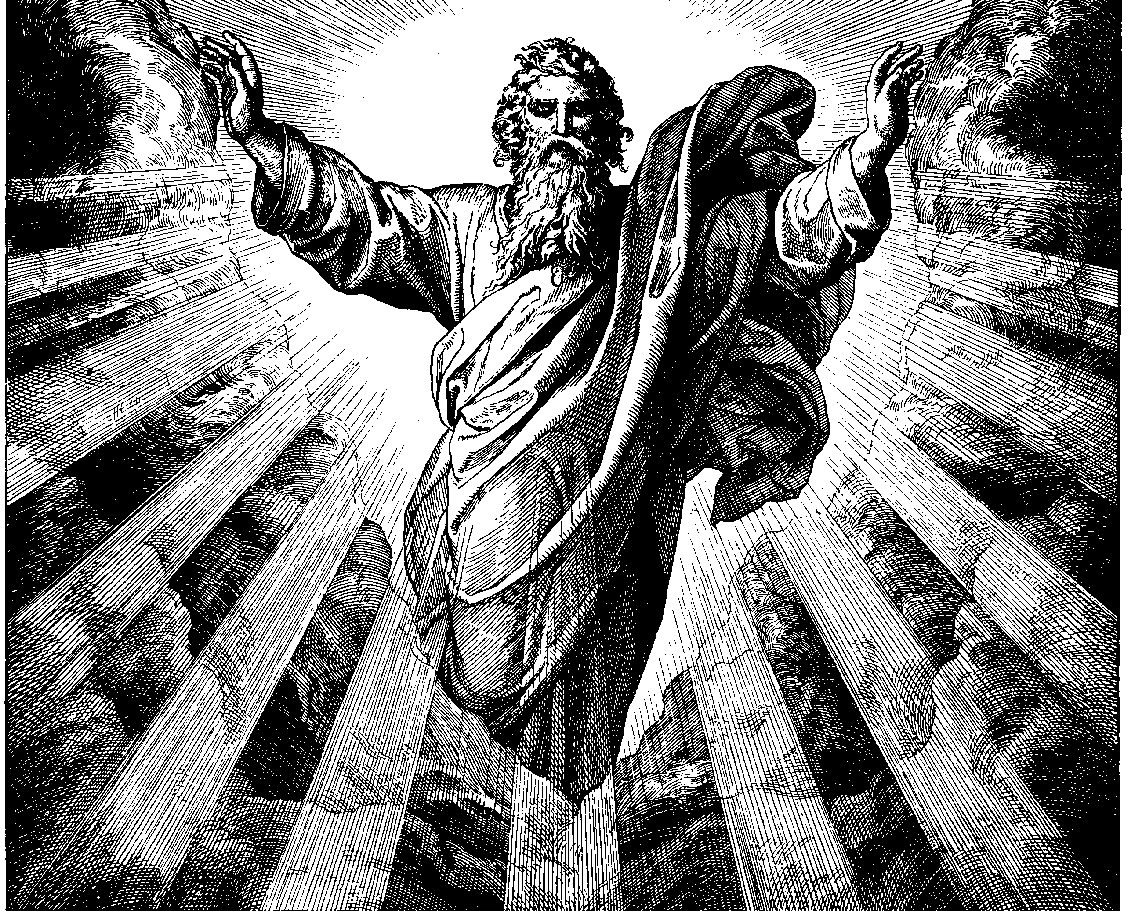|
Henotheism
Henotheism is the worship of a single, supreme god that does not deny the existence or possible existence of other deities that may be worshipped. Friedrich Schelling (1775–1854) coined the word, and Friedrich Welcker (1784–1868) used it to depict primitive monotheism among ancient Greeks. Max Müller (1823–1900), a British philologist and orientalist, brought the term into wider usage in his scholarship on the Indian religions, particularly Hinduism, whose scriptures mention and praise numerous deities as if they are one ultimate unitary divine essence. Müller made the term central to his criticism of Western theological and religious exceptionalism (relative to Eastern religions), focusing on a cultural dogma which held "monotheism" to be both fundamentally well-defined and inherently superior to differing concepts of God. Definition and terminology Friedrich Schelling coined the German term and German 'theism' (which comes ). The term refers to a fo ... [...More Info...] [...Related Items...] OR: [Wikipedia] [Google] [Baidu] |
Deities
A deity or god is a supernatural being considered to be sacred and worthy of worship due to having authority over some aspect of the universe and/or life. The ''Oxford Dictionary of English'' defines ''deity'' as a God (male deity), god or goddess, or anything revered as divine. C. Scott Littleton defines a deity as "a being with powers greater than those of ordinary humans, but who interacts with humans, positively or negatively, in ways that carry humans to new Higher consciousness, levels of consciousness, beyond the grounded preoccupations of ordinary life". Religions can be categorized by how many deities they worship. Monotheism, Monotheistic religions accept only one deity (predominantly referred to as "God"), whereas Polytheism, polytheistic religions accept multiple deities. Henotheism, Henotheistic religions accept one God, supreme deity without denying other deities, considering them as aspects of the same divine principle. Nontheistic religions deny any supreme eter ... [...More Info...] [...Related Items...] OR: [Wikipedia] [Google] [Baidu] |
Theism
Theism is broadly defined as the belief in the existence of at least one deity. In common parlance, or when contrasted with '' deism'', the term often describes the philosophical conception of God that is found in classical theism—or the conception found in monotheism—or gods found in polytheistic religions—or a belief in God or gods without the rejection of revelation, as is characteristic of deism. Non-theism and atheism is commonly understood as non-acceptance or outright rejection of theism in the broadest sense of the term (i.e., non-acceptance or rejection of belief in God or gods). Related (but separate) is the claim that the existence of any deity is unknown or unknowable; a stance known as agnosticism.(page 56 in 1967 edition) ''Agnostic theism'' is a personal belief in one or more deities along with acceptance that the existence or non-existence of the deity or deities is fundamentally unknowable. A 2020 ''Philpapers'' survey of professional philosophers fo ... [...More Info...] [...Related Items...] OR: [Wikipedia] [Google] [Baidu] |
Hinduism
Hinduism () is an Hypernymy and hyponymy, umbrella term for a range of Indian religions, Indian List of religions and spiritual traditions#Indian religions, religious and spiritual traditions (Sampradaya, ''sampradaya''s) that are unified by adherence to the concept of ''dharma'', a Ṛta, cosmic order maintained by its followers through rituals and righteous living, as expounded in the Vedas. The word ''Hindu'' is an exonym, and while Hinduism has been called the oldest religion in the world, it has also been described by the modern term ''Sanātana Dharma'' () emphasizing its eternal nature. ''Vaidika Dharma'' () and ''Arya dharma'' are historical endonyms for Hinduism. Hinduism entails diverse systems of thought, marked by a range of shared Glossary of Hinduism terms, concepts that discuss God in Hinduism, theology, Hindu mythology, mythology, among other topics in Hindu texts, textual sources. Hindu texts have been classified into Śruti () and Smṛti (). The major Hin ... [...More Info...] [...Related Items...] OR: [Wikipedia] [Google] [Baidu] |
Monotheism
Monotheism is the belief that one God is the only, or at least the dominant deity.F. L. Cross, Cross, F.L.; Livingstone, E.A., eds. (1974). "Monotheism". The Oxford Dictionary of the Christian Church (2 ed.). Oxford: Oxford University Press. A distinction may be made between exclusive monotheism, in which the one God is a singular existence, and both inclusive and pluriform monotheism, in which multiple gods or godly forms are recognized, but each are postulated as extensions of the same God. Monotheism is distinguished from henotheism, a religious system in which the believer worships one god without denying that others may worship different gods with equal validity, and monolatry, monolatrism, the recognition of the existence of many gods but with the consistent worship of only one deity. The term ''monolatry'' was perhaps first used by Julius Wellhausen. Monotheism characterizes the traditions of Abrahamic religions, Abrahamic religions such as Judaism, Samaritanism, Christi ... [...More Info...] [...Related Items...] OR: [Wikipedia] [Google] [Baidu] |
Monolatry
Monolatry (, and ) is the belief in the existence of many gods, but with the consistent worship of only one deity. The term ''monolatry'' was perhaps first used by Julius Wellhausen. Atenism The pharaoh Akhenaten, who was initially enthroned as Amenhotep IV, initially introduced Atenism in the fifth year (approximately 1348–1346 BCE) of his reign during the Eighteenth Dynasty of Egypt. He raised Aten, once a relatively obscure solar deity representing the disk of the Sun, to the status of supreme deity in ancient Egyptian religion. The fifth year of his reign marked the beginning of his construction of a new capital, ''Akhetaten'' (Horizon of the Aten), at the site known today as " Amarna". Amenhotep IV officially changed his name to "Akhenaten" (Agreeable to the Aten) as evidence of his new worship. In addition to constructing a new capital in honor of Aten, Akhenaten also oversaw the construction of some of the most massive temple complexes of ancient Egypt, inclu ... [...More Info...] [...Related Items...] OR: [Wikipedia] [Google] [Baidu] |
Sraosha
Sraosha ( or ; ), is the Avestan name of the Zoroastrian '' yazata'' of "Conscience" and "Observance", which is also the literal meaning of his name. In the Middle Persian commentaries of the 9th-12th centuries, the divinity appears as '', S(a)rosh''. This form appears in many variants in New Persian as well, for example , ''Sorūsh''. Unlike many of the other Yazatas (concepts that are "worthy of adoration"), Soroush is also frequently referred to as the "Angel of Conscience" or "Voice of Conscience", which overlaps with both of his role as the "Teacher of Daena", Daena being the hypostasis of both "Conscience" and "Religion" and Guardian/Companion over the Chinvat Bridge. Soroush is also the Persian name of the angel Gabriel in Abrahamic religions and the angel Jibril in Islam. In scripture In Zoroaster's revelation Soroush is already attested in the Gathas, the oldest texts of Zoroastrianism and believed to have been composed by Zoroaster himself. In these earliest t ... [...More Info...] [...Related Items...] OR: [Wikipedia] [Google] [Baidu] |
Ahura Mazda
Ahura Mazda (; ; or , ),The former is the New Persian rendering of the Avestan form, while the latter derives from Middle Persian. also known as Horomazes (),, is the only creator deity and Sky deity, god of the sky in the ancient Iranian religion Zoroastrianism. He is the first and most frequently invoked spirit in the ''Yasna''. The literal meaning of the word ''Wikt:Ahura, Ahura'' is "lord", and that of ''Wikt:Mazda, Mazda'' is "wisdom". The first notable invocation of Ahura Mazda occurred during the Achaemenid Empire, Achaemenid period () with the Behistun Inscription of Darius the Great. Until the reign of Artaxerxes II (), Ahura Mazda was worshipped and invoked alone in all extant royal inscriptions. With Artaxerxes II, Ahura Mazda was gathered in a triad with Mithra and Anahita. In the Achaemenid period, there are no known representations of Ahura Mazda at the royal court other than the custom for every emperor to have an empty chariot drawn by white horses to invit ... [...More Info...] [...Related Items...] OR: [Wikipedia] [Google] [Baidu] |
Yazatas
Yazata () is the Avestan word for a Zoroastrian concept with a wide range of meanings but generally signifying (or used as an epithet of) a divinity. The term literally means "worthy of worship or veneration",.. and is thus, in this more general sense, also applied to certain healing plants, primordial creatures, the ''fravashis'' of the dead, and to certain prayers that are themselves considered holy. The ''yazata''s collectively are "the good powers under Ahura Mazda", who is "the greatest of the ''yazata''s". Etymology ''Yazata'' is an Avestan-language passive adjectival participle derived from ''yaz-''; "to worship, to honor, to venerate", from Proto-Indo-European ''*yeh₂ǵ-'' (“to worship, revere, sacrifice”). The word ''yasna'' or yagna– "worship, sacrifice, oblation, prayer" – comes from the same root. A ''yaza+ ta'' is accordingly "a being worthy of worship", "an object of worship" or "a holy being". As the stem form, ''yazata-'' has the inflected nominati ... [...More Info...] [...Related Items...] OR: [Wikipedia] [Google] [Baidu] |
Anahita
Anahita is the Old Persian form of the name of an Iranian goddess and appears in complete and earlier form as ('), the Avestan name of an Indo-Iranian cosmological figure venerated as the divinity of "the Waters" ( Aban) and hence associated with fertility, healing and wisdom. There is also a temple named Anahita in Iran. Aredvi Sura Anahita is ''Ardwisur Anahid'' (اردویسور آناهید) in Middle and Modern Persian, and '' Anahit'' in Armenian. An iconic shrine sects of Aredvi Sura Anahita was, together with other shrine sects, "introduced apparently in the 4th century BCE and lasted until it was suppressed in the wake of an iconoclastic movement under the Sasanids.". The symbol of goddess Anahita is the Lotus flower. Lotus Festival (Persian: Jashn-e Nilupar) is an Iranian festival that is held on the end of the first week of July. Holding this festival at this time was probably based on the blooming of lotus flowers at the beginning of summer. The Greek and R ... [...More Info...] [...Related Items...] OR: [Wikipedia] [Google] [Baidu] |
Rashnu
Rashnu () is the Avestan language name of the Zoroastrian ''yazata'' of justice. Together with Mithra and Sraosha, Rashnu is one of the three judges who pass judgment on the souls of people after death. Rashnu's standard appellation is "the very straight." In creation accounts In the ''Bundahishn'', a Zoroastrian account of creation finished in the 11th or 12th century, Rashnu (Middle Persian: ''Rashn'') is identified as an assistant of the Amesha Spenta ''Ameretat'' (Amurdad), "immortality". (''GBd'' xxvi.115). In a subsequent passage, Rashnu is described as the essence of truth ('' arta/asha'') that prevents the ''daeva''s from destroying material Creation. "Rashnu adjudges even the souls of men and women as to bad deeds and good deeds. As one says, 'Rashnu shall not see thither the rank of the judge who delivers false judgment.'" (''GBd'' xxvi.116-117). In other texts In the Avestan Dahman Afrin, Rashnu is invoked in an address to Ameretat. According to the ''Denkard'', ... [...More Info...] [...Related Items...] OR: [Wikipedia] [Google] [Baidu] |
Mithra
Mithra ( ; ) is an ancient Iranian deity ('' yazata'') of covenants, light, oaths, justice, the Sun, contracts, and friendship. In addition to being the divinity of contracts, Mithra is also a judicial figure, an all-seeing protector of Truth (''Asha''), and the guardian of cattle, the harvest, and the Waters. The Romans attributed their Mithraic mysteries to Zoroastrian Persian sources relating to Mithra. Since the early 1970s, the dominant scholarship has noted dissimilarities between the Persian and Roman traditions, making it, at most, the result of Roman ''perceptions'' of Zoroastrian ideas. Etymology Together with the Vedic common noun ''mitra'', the Avestan common noun ''miθra'' derives from Proto-Indo-Iranian '' *mitrám'' (Mitra), from the root ''*mi-'' "to bind", with the "tool suffix" ''-tra-'' "causing to". Thus, etymologically ''mitra''/''miθra'' means "that which causes binding", preserved in the Avestan word for "Covenant, Contract, Oath". In Middle Ir ... [...More Info...] [...Related Items...] OR: [Wikipedia] [Google] [Baidu] |
Syncretism
Syncretism () is the practice of combining different beliefs and various school of thought, schools of thought. Syncretism involves the merging or religious assimilation, assimilation of several originally discrete traditions, especially in the theology and mythology of religion, thus asserting an underlying unity and allowing for an Inclusivism, inclusive approach to other faiths. While syncretism in art and culture is sometimes likened to eclecticism, in the realm of religion, it specifically denotes a more integrated merging of beliefs into a unified system, distinct from eclecticism, which implies a selective adoption of elements from different traditions without necessarily blending them into a new, cohesive belief system. Etymology The English word is first attested in the early 17th century. It is from Neo-Latin, Modern Latin , drawing on the (), supposedly meaning "Cretan federation". However, this is a spurious etymology derived from the naive idea in Plutarch's 1st- ... [...More Info...] [...Related Items...] OR: [Wikipedia] [Google] [Baidu] |







